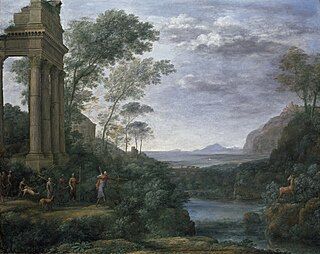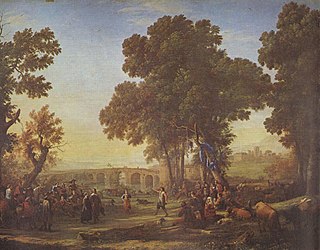 W
WSeaport with the Embarkation of the Queen of Sheba is an oil painting by Claude Lorrain, in the National Gallery, London, signed and dated 1648. The large oil on canvas painting was commissioned by Frédéric Maurice de La Tour d'Auvergne, Duc de Bouillon, general of the Papal army, together with Claude's Landscape with the Marriage of Isaac and Rebecca, also now in the National Gallery. It depicts the departure of the Queen of Sheba to visit King Solomon in Jerusalem, described in the tenth chapter of the First Book of Kings. A more usual subject would be their meeting; this is one of many harbour scenes painted by Claude. The Queen is departing from a city with classical buildings, with the early morning Sun lighting the sea, as vessels are loaded.
 W
WThe Flight into Egypt is a 1635 oil painting by French artist Claude Lorrain, located in the Indianapolis Museum of Art, which is in Indianapolis, Indiana. It depicts the Flight into Egypt, when the Holy Family fled to Egypt to escape Herod's persecution.
 W
WThe Ford or Landscape with Shepherds is a 1644 painting by Claude Lorrain, now in the Prado Museum in Madrid.
 W
WLandscape with Ascanius Shooting the Stag of Sylvia is a painting of 1682 in oil on canvas by Claude Lorrain, a painter from the Duchy of Lorraine who spent his career in Rome. It was painted in Rome for Prince Lorenzo Onofrio Colonna (1637–1689), Claude's most important patron in his last years, and is now in the Ashmolean Museum, Oxford. It is signed, dated with the year, and inscribed with the subject, as Claude sometimes did with his less common subjects.
 W
WLandscape with Psyche Outside the Palace of Cupid, or The Enchanted Castle, 1664, is a painting, oil on canvas, by Claude Lorrain in the National Gallery, London. It was commissioned by Lorenzo Onofrio Colonna, a Roman aristocrat. Its subject is taken from The Golden Ass (IV-VI), by Apuleius – the love story of Psyche the soul, and Cupid the god of love. It is not clear if Psyche sits in front of Cupid's castle before she meets him, or after he has abandoned her.
 W
WLandscape with St María de Cervelló is a 1637 painting by Claude Lorrain, an early work from a series commissioned from the artist by Philip IV of Spain for the palacio del Buen Retiro. It is now in the Prado Museum in Madrid. It shows the eponymous saint praying in the left foreground.
 W
WLandscape with Saint Paula of Rome Embarking at Ostia or The Embarkation of Saint Paula is an oil-on-canvas painting by Claude Lorrain. It was painted in 1639–1640 as one of a series of works commissioned by Philip IV of Spain for a gallery of landscapes at the Palacio del Buen Retiro – he also commissioned works from Nicolas Poussin, Herman van Swanevelt, Jan Both, Gaspard Dughet and Jean Lemaire. It is now in the Museo del Prado in Madrid.
 W
WLandscape with the Burial of St. Serapia is a 1639–40 painting by Claude Lorrain, one of several commissioned from the artist by Philip IV of Spain and now in the Prado Museum. it shows the burial of Saint Serapia, slave to Saint Sabina – the lid of the sarcophagus is shown with the inscription SEPVLTVRA.S.SABIN (a)... SEPELIR(e) IVBET.C.SANCTAE SERAPI(ae). Her martyrdom occurred in Vindena, now known to have been sited near Terni, although at the time the painting was produced it was thought to be located on the Aventine Hill.
 W
WLandscape with the Finding of Moses is an oil painting on canvas of 1639–40 by Claude Lorrain, one of a series commissioned from the artist by Philip IV of Spain for the Palacio del Buen Retiro. It is now in the collection of the Museo del Prado.
 W
WLandscape with the Temptation of St Anthony is a 1637 or 1638 painting by Claude Lorrain, now in the Prado Museum in Madrid. It was one of several paintings commissioned from the artist for the palacio del Buen Retiro.
 W
WLandscape with Tobias and Raphael is a 1639-40 painting by Claude Lorrain, one of a series of paintings commissioned from the artist for the Palacio del Buen Retiro and now in the Prado Museum in Madrid.
 W
WThe Liber Veritatis, meaning Book of Truth in Latin, is a book of drawings recording his completed paintings made by Claude Lorrain, known in English as "Claude". Claude was a landscape painter in Rome, who began keeping this record in 1635/6, as he began to be highly successful, and maintained it until his death in 1682. The book is now in the British Museum, and was owned by the Dukes of Devonshire from the 1720s until 1957. It was reproduced in print form from 1774 to 1777 by Richard Earlom and had a considerable influence on British landscape art. The title Liber Veritatis was apparently invented for these reproductions, but is now also used for the original.
 W
WSeaport with the Embarkation of Saint Ursula is an oil painting on canvas of 1641 by Claude Lorrain, signed and dated by the artist. The work was produced for Fausto Poli, who two years later was made a cardinal by Pope Urban VIII. It is now in the National Gallery in London, which acquired it in 1824 as part of the collection of John Julius Angerstein.
 W
WThe Trojan Women Set Fire to their Fleet is a mid-17th century painting by French artist Claude Lorrain. Done in oil on canvas, the painting is currently in the collection of the Metropolitan Museum of Art.
 W
WVillage Fête is an oil-on-canvas by French artist of the Baroque Claude Lorrain, painted in 1639 and given to Louis XIV in 1693 together with its companion Seaport at Sunset, by landscape architect and gardener André Le Nôtre. It is currently held and exhibited at the Louvre in Paris.